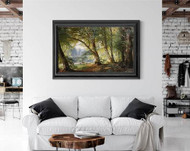Carl Frederik Peder Aagaard
Published by Elizabeth Goodman on 18th May 2019
Carl Frederik Peder Aagaard, best known for his landscape oil paintings, like Pergola in Amalfi, inspired by a trip he took to Italy to exhibit his work, was born into Denmark's Golden Age. His career would begin toward the end of this remarkable time that was precipitated by Danish Navy being defeated by the British in 1801, the bombardment by the English of Copenhagen in 1807 that destroyed numerous buildings in this capital city, the national bankruptcy that was declared in 1813 and then the loss of Norway, the Danish people set out on a willful mission to remain relevant and regain strength. These disasters would serve to galvanize the people of this weakened country fostering a great era of Danish painting from 1800 to roughly 1850, marking this period of creativity called the Danish Golden Age.
Artists are largely regarded as being slightly more emotional than the rest of society. Capturing all that was going wrong in Denmark at this time was rather cathartic for these artists. It was a way to express what they were seeing, and how they were feeling about this sequential series of bad events that would serve to change the face of their country forever. It also captured the evolution of the rebuilding of Copenhagen, and the subsequent development of Neoclassical style of Danish architecture.
Carl Frederik Peder Aagaard captured nature and wildlife in his oil-on-canvas productions. Deer at the Bend of River, dated to May of 1877, is a highly-regarded work of this painter who was just 17 years old at the end of Denmark's thriving Golden Age, and was 44 years old when he created this painting. Much of what was created during the Golden Age was reflective of the tumultuousness washing over this country. This painting could be regarded as indicative of the peace that was now marking the experience of Danish citizens.
Beginning his career as an artist toward the end of this fabled age, Mr. Aagaard would benefit enormously by learning under the tutelage of the famous artists that were teaching at the Danish Royal Academy, which he attended to learn more about drawing, and to develop and hone his skill. He also worked with his brother, a glass engraver, at his studio. His move into oil painting would come as the result of his studying under Hilker, an oil painted he collaborated with. By 1857, Aagaard would gain some notoriety. History marks this transition as being the result of his learning from Peter Kristian Skoovgaard, a landscape oil painter who would prove influential over Mr. Aagaard's career. It was at this time he was able to exhibit his paintings, for the first time, to great acclaim. Further inspiration would be garnered from those original exhibition successes by traveling to both Switzerland and Italy to display his work.
Born in 1833, and dying in 1895, Mr. Aagaard's development occurred at a very fortuitous time indeed. Throughout his career, he would benefit by learning from some of the most skilled artists who captured the evolution of Denmark's Golden Age through the timeless expression of oil on canvas.
You can view our Carl Frederik Peder Aagaard Gallery.

